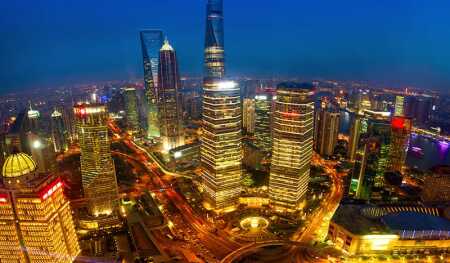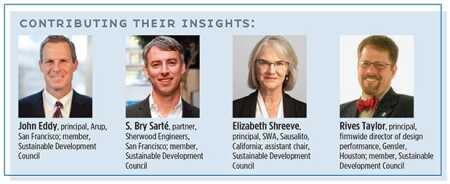Members of ULI’s Sustainable Development Councildiscuss ideas for redesigning the urban realm in ways that consume fewer resources and reduce or reverse environmental impacts. New technologies include driverless vehicles, decentralized water systems, landscapes that filter water, and buildings that reduce urban air pollution.
What sustainable design ideas do you wish more people knew about?
ELIZABETH SHREEVE: One of the terms we use a lot these days in our work is performative landscape—a manmade landscape that takes on ecological functions. It doesn’t just look like it’s replicating nature; it actually performs natural functions, such as improving water quality, filtering contaminants, generating healthy soils, and fostering healthy wildlife habitats—all while reducing maintenance requirements and the need for fertilizer and irrigation. We can treat stormwater in ways that enable the surface drainage and planting to harmonize with what
the natural ecology of the area can support, without human intervention. That results in much lower costs, much lower rates of erosion, and higher water quality.
JOHN EDDY: Driverless vehicles are going to significantly alter the city landscape. They will accelerate the changeover of our primary fuel from hydrocarbons to electricity. Energy efficiency will improve, because the cars will be driven optimally, which humans aren’t really good at. Once the vehicle fleet is completely driverless, vehicle size and shape will change dramatically, which will reduce the use of resources required to manufacture and operate the vehicles. The ubiquitous nature of parking will change, because a smaller fleet will require less square footage for parking. Driverless vehicles are going to have a very big impact on the way the city landscape operates, and very soon. Even just two years ago, the industry money was on 2025 as a target date for their arrival. That’s already moved up to nearly 2020.
RIVES TAYLOR: Many of our clients—even speculative developers—are taking seriously the power of providing a connection to nature. There are a lot of ways to bring nature into the built environment, whether it’s through green roofs, living walls, or plants in building lobbies. In office buildings, incorporating natural elements and views of nature in amenity spaces can create a place for rejuvenation within the 24/7 work environment we’ve created for ourselves. These simple things [have an impact on] people’s perception of the quality of the space they inhabit, and our clients see a return on their investment.
What misperceptions about sustainable design remain?
S. BRY SARTÉ: Sustainability has been almost entirely focused on energy and green buildings, and I think there’s an opportunity for sustainable design to do a lot more. The thinking around resilience has helped to expand that conversation. The whole point of sustainable design wasn’t just to become more energy efficient or to have a high-performing building, but also to better balance human development with respect to nature. With ever-increasing global populations and ever-declining biodiversity and access to resources, addressing larger-scale issues through technological innovation is really our only way out at this point. We need to think about these things holistically.
SHREEVE: Developers sometimes initially think that increasing the sustainability of a landscape design project increases the cost. In fact, cost savings are actually possible, both in the initial capital improvement costs and in maintenance costs over the lifetime of the landscaping. For example, if you have a landscape solution that improves water quality or drainage, then you can get more bang for your buck. You get an aesthetic solution. You usually have an easier time getting entitlements. And you can meet an infrastructure requirement at the same time. So good site planning can often produce a more costeffective solution that may require less upgrading, less engineering, even less hardscape.
TAYLOR: The message about the value of sustainability is out there, but in some ways we’ve reached only the top 5 percent of the development industry. We’ve been successful in discussing sustainability in the corporate and AA or A speculative markets, but in the B and C markets, there is not as much awareness of the value of sustainable design. And many schools, churches, and other existing buildings where we spend a lot of time could be more effectively designed. In Texas, even in places where there has been progress with energy optimization, some homebuilders are pushing back now, saying that the energy requirement targets might be too aggressive and cost too much money or limit job opportunities. So we need to keep educating.
What are some promising ideas for addressing water-related issues, whether in terms of managing sea-level rise and flash flooding or in terms of conservation and efficiency?
EDDY: It has become far less expensive to perform real-time monitoring of the various conditions of the world, such as water quality, stormwater quality, and air quality. This will enable us to find out if many of our models are valid. Stormwater quality management in particular has been dominated by best practices, but we will soon know whether those best practices are actually effective. As much as I’d like to think that the strategies we put into place for improving water quality are effective, like bioswales and rain gardens, it will be nice to have the data to back them up.
SARTÉ: We have to look at how infrastructure, resilience, and public space all come together. It’s easy to think about just building a sea wall, for example, as a hard edge to a city to protect against future storm surges and other climate challenges. But we need to figure out how to create a more dynamic system that can also offer a public benefit and an ecological benefit. That same idea extends to things like decentralized water treatment. If we’re having trouble providing for populations with remote centralized water processing, whether it’s water supply or wastewater treatment, then we need decentralized systems that are integrated into the urban fabric. Careful, thoughtful work is occurring at that district scale, where real efficiencies are possible in terms of water stewardship, recovering water before it leaves the site. We’re able to show very favorable paybacks in less than ten years for an on-site, closed-loop water system. Decentralized water systems offer an attractive investment opportunity.
SHREEVE: California is in a water crisis. So we’re not going to be able to have water-thirsty lawns and flowering shrubs that are exotic species. We’re going to have to start to love a much more arid landscape palette than we’re used to and rely almost entirely on native and Mediterranean plants. We’ll need to design drought-tolerant landscapes in a way that meets the aesthetic goals of our clients and meets the maintenance realities in a time of drought.
TAYLOR: Many of our clients need to use water in a way that’s very visible to the community, whether it’s a corporate campus that has cooling towers and a landscape requiring irrigation, or a retail automobile dealership that has a lot of cars to wash. With these clients, we’re focusing on what we call a water-mapping process. You can collect rainwater or condensate or ground water, or use more-efficient fixtures that cost the same as conventional ones. For the Toyota dealerships that I’ve had the opportunity to advise, water is a very good story, because it can be pretty simply and inexpensively optimized and it pays for itself faster than most expect—and it’s a great marketing/brand story for the dealer.
What are some big sustainable design challenges that remain to be solved?
EDDY: The utility corridors that we’ve created are highly inefficient. We need a way of merging the movement of everything that uses those corridors, whether it’s people, goods, electrons, gas, fuel, or data. The streets in urban areas are packed with this stuff, but in more suburban areas, we’re traversing hundreds of miles with power and gas lines. Those corridors could be constructed and managed in a way that would be much more efficient, both in the use of land and in the use of energy it takes to create the corridors.
SARTÉ: One really interesting challenge is to create a “cool factor” for water infrastructure. How can we make infrastructure interesting and engaging? How can we get the public behind projects and see some big investments in integrating large-scale restorative systems into the urban fabric? Another challenge is that there are a lot of regulatory barriers. The way that buildings and infrastructure are designed, permitted, constructed, and operated—all of those steps need transformation. But turning around a ship as big as the construction industry takes time.SHREEVE: One of the challenges that we have in designing more-walkable projects is to educate public works departments about the value of prioritizing pedestrians and bicyclists. Cities have focused so much on providing for fast-moving traffic that we have demoted the pedestrian and the bicyclist to unsafe, marginal portions of the urban environment. Cities need to adopt complete-street standards and make pedestrians feel comfortable. Right now, it’s so hard to design a project without incorporating very wide rights-of-way for fire trucks, for example. The street widths required for fire truck access are actually going up. Here in California, traffic congestion is terrible. We need to get cities to agree on regional decision making about transit and walkability so that people have options to walk to work, school, shopping, and other destinations.
What other trends or intriguing ideas do you see on the horizon?
TAYLOR: A concept that some folks from Gensler’s Shanghai office presented to the firm recently was really intriguing: can we make buildings reduce air pollution, especially in countries where air pollution is extreme? We already have to filter the outside air anyway as we bring it into the buildings. Might we find a way to clean air, internally and externally, at scale? That could include adding landscaping, creating sky lobbies with greenery, and shaping the building to be tall rather than broad in order to make more room for green space. Think of Shanghai or São Paulo—full of buildings with upgraded mechanical systems that filter more air than they need. Of course, that increases energy usage, but if we use renewable energy, that will help bring down the cost.
SARTÉ: Democratizing the innovations that have been pioneered is a gradual process that’s occurring right now. The rapid evolution in technology is bringing new kinds of systems and opportunities to a much broader cross section of humanity. You have centralized water systems regulated by government utilities; you have individual wells on people’s properties; and [you have] a variety of structures in between. But the district- or neighborhood- or community-scale water system, where you put control of water resources in the users’ hands, is the next frontier. Giving people the opportunity to invest in and manage their own water resources is in line with the idea of access to water as a basic human right.
EDDY: The word flexibility has entered into the discussion about the built environment. Make it flexible, make it adjustable and adaptable. That makes sense from a sustainability perspective—if we don’t invest so much carbon in building things, we won’t be reluctant to change them. But does that mean the end of creating iconic buildings, which we design and maintain to keep around a long time? The culture that we will leave could be one of temporariness. Another challenge is reusing materials when we tear down or renovate buildings. Somebody needs to invent reusable drywall. Currently, office building renovations fill Dumpster after Dumpster [with] drywall. We’ve got to work harder to enable meaningful reuse of resources without requiring a lot of energy to convert a building product into another usable form.
RON NYREN is a freelance architecture and urban planning writer based in the San Francisco Bay area.




![Western Plaza Improvements [1].jpg](https://cdn-ul.uli.org/dims4/default/15205ec/2147483647/strip/true/crop/1919x1078+0+0/resize/500x281!/quality/90/?url=https%3A%2F%2Fk2-prod-uli.s3.us-east-1.amazonaws.com%2Fbrightspot%2Fb4%2Ffa%2F5da7da1e442091ea01b5d8724354%2Fwestern-plaza-improvements-1.jpg)


